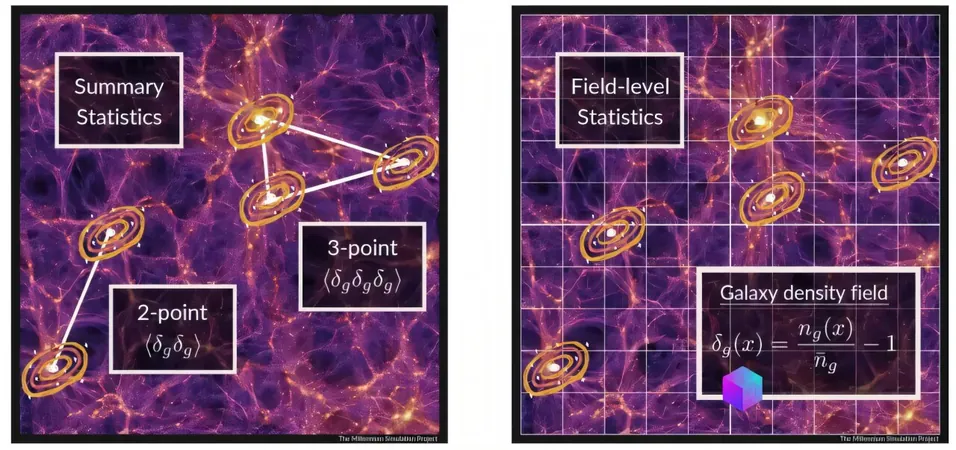
Revolutionary Advances in Galaxy Mapping: Unlocking New Physics in the Cosmos!
2025-01-07
Author: John Tan
Introduction
Galaxies are not solitary entities floating in the vastness of space; they are integral components of a larger cosmic tapestry. While the universe is expanding—a phenomenon attributed to the enigmatic force known as 'dark energy'—galaxies tend to cluster together, forming a complex cosmic web held together by the attractive force of dark matter.
Galaxies as Test Particles
For cosmologists, these galaxies serve as critical 'test particles' that provide insights into the fundamental forces of gravity, dark matter, and dark energy. Recently, a groundbreaking study led by researchers from the Max Planck Institute (MPA) introduces an innovative method that fully harnesses the potential embedded in galaxy maps. This new technique promises to rigorously test the current cosmological models and may illuminate the mysteries of gravity and the dark universe.
The Cosmic Web
The origins of this intricate cosmic web can be traced back to tiny fluctuations that gave rise to today’s diverse galaxy structures, including vast clusters linked by cosmic filaments with empty voids interspersed. However, capturing and analyzing the distribution of millions of galaxies is no simple task. Traditionally, researchers have relied on compressing the three-dimensional distribution of these galaxies into simpler assessments, known as two- and three-point correlation functions. While this conventional approach has its merits, it likely overlooks crucial information contained in smaller spatial scales.
LEFTfield: A New Analytical Method
A recent publication in Physical Review Letters highlights the significance of an advanced analytical method developed by Dr. Minh Nguyen and his team at MPA. This innovative approach, aptly named LEFTfield, employs a probabilistic framework for modeling galaxy clustering that stretches beyond the capabilities of older methods.
How LEFTfield Works
LEFTfield stands out by utilizing the Effective Field Theory of Large-Scale Structure (EFTofLSS) to create reliable predictions from the observed galaxy field with remarkable efficiency. What's revolutionary about LEFTfield is its ability to preserve all the valuable data contained in the three-dimensional galaxy distribution, making it possible for scientists to perform field-level inference (FLI) of cosmological model parameters and primordial fluctuations.
Comparative Studies and Findings
In their study, the researchers conducted a head-to-head comparison between the FLI method and the traditional two-point plus three-point analysis. They focused on the same galaxy data set and scales and, interestingly, found that FLI enhanced the constraints on the amplitude of structure growth by an impressive factor of three to five. This substantial improvement demonstrates that even without delving into extremely small scales, we can extract significantly more information from galaxy clustering by simply avoiding data compression.
Implications of LEFTfield
The implications of such advancements are astounding. With a five-fold increase in parameter constraints, researchers effectively enhance survey volumes by more than ten times—an invaluable gain considering the arduous and costly processes involved in extensive galaxy mapping. Moreover, FLI promises an optimal extraction of cosmological information, eliminating data compression and preventing any loss of critical information.
Future Research Directions
While the study mainly involved dark matter halos in simulations, parallel investigations—including one by the Beyond-2pt Collaboration—have shown that the FLI method remains applicable to larger, more realistic galaxy simulations, yielding improved constraints on cosmic structure growth.
Beyond Parameter Refinement
Beyond merely refining parameter estimates, the LEFTfield approach opens new avenues for identifying potential evidence of physics beyond the standard cosmological model. Researchers can pinpoint regions of the universe that deviate most significantly from established models, prompting deeper investigations into the underlying causes of such anomalies. Additionally, by correlating inferred matter density with gravitational lensing maps, scientists can cross-validate their findings using independent datasets, enriching our understanding of the cosmos.
Conclusion
As we stand on the brink of unlocking these new horizons in galaxy mapping, the potential for groundbreaking discoveries in cosmology has never been more promising! What secrets of the universe will we uncover next? Stay tuned as we continue to explore the depths of space and time!

 Brasil (PT)
Brasil (PT)
 Canada (EN)
Canada (EN)
 Chile (ES)
Chile (ES)
 Česko (CS)
Česko (CS)
 대한민국 (KO)
대한민국 (KO)
 España (ES)
España (ES)
 France (FR)
France (FR)
 Hong Kong (EN)
Hong Kong (EN)
 Italia (IT)
Italia (IT)
 日本 (JA)
日本 (JA)
 Magyarország (HU)
Magyarország (HU)
 Norge (NO)
Norge (NO)
 Polska (PL)
Polska (PL)
 Schweiz (DE)
Schweiz (DE)
 Singapore (EN)
Singapore (EN)
 Sverige (SV)
Sverige (SV)
 Suomi (FI)
Suomi (FI)
 Türkiye (TR)
Türkiye (TR)
 الإمارات العربية المتحدة (AR)
الإمارات العربية المتحدة (AR)